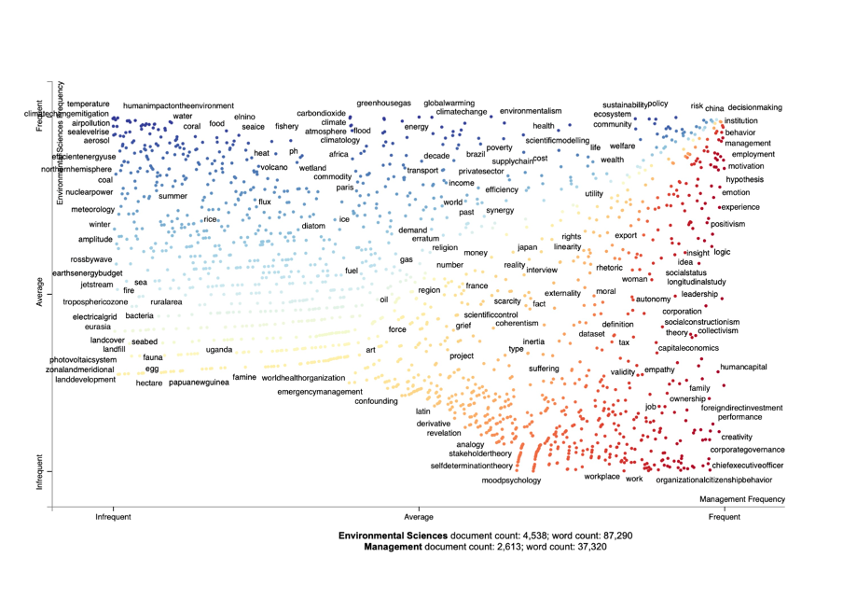Summary of “Interdisciplinary Research Maps: A new technique for visualizing research topics”(Marrone & Linnenluecke, 2020)
Interdisciplinary research is challenging, in part due to the sheer magnitude of knowledge embedded within disciplines, and also to the lack of a common shared understanding across them.
To bridge the gap in understanding between the disciplines of business/management and the environmental sciences, Marrone & Linnenluecke (2020) developed a ‘map’ of topics, concepts, and ideas discussed in top publications in these fields of research.
Developing the map
- Data for the study was sourced by selecting articles published since 2011 in the top four journals by impact factor in each field, through the Scopus database. The abstracts, titles and publication years of 4,827 environmental sciences articles and 2,671 business and management articles were downloaded.
- These data were exported to two separate Comma Separated Values (CSV) files, one for each of the areas of interest. The titles of the publications were then merged with their respective abstracts and the files were analysed using TAGME entity linking tool to compile a list of all possible topics from the text in the abstracts and titles.
- The researchers ‘cleaned’ the results of the analysis by deleting topics that made little meaningful sense, given the context in which they were used. After cleaning the results, 7,915 topics were retained in the environmental sciences articles, and 4,293 in business/management articles.
- A map was created (see figure below) to show the frequency with which topics are mentioned in each field.
What the map tells us
1. Topics that are frequently identified in one literature, but not the other
Some topics are represented almost exclusively in the environmental sciences articles, many of them linked to concerns about climate change. Meanwhile, in the business/management journals, the topics which arise most frequently are related to firm structure and expansion. There is an opportunity here, for future research to connect topics across these two fields. For example, further interdisciplinary research could serve to explore the impacts of climate change on business and management decisions, such as asset valuations and investments.
2. Topics that are frequently associated with both literatures
Several topics are common to both sets of literature. For example, “decision-making” is a frequently discussed topic in both business/management and the environmental sciences. The topic of “China” also arises frequently in both disciplines, but in different ways. Articles in the business/management journals address management challenges and economic opportunities in China, while the those in the environmental sciences journals address the role of emerging economies like China’s in climate adaptation and mitigation efforts. Such areas of topic convergence may provide fruitful avenues for future interdisciplinary research.

Figure 1: Topics are represented as dots; those associated with the business/management literature are coloured red, and those associated with the environmental sciences blue.
Reference:
Marrone, M. and Linnenluecke, M.K., 2020. Interdisciplinary Research Maps: A new technique for visualizing research topics. Plos one, 15(11), p.e0242283.

